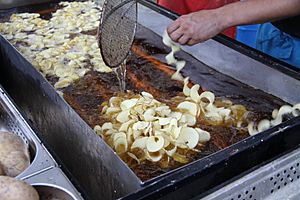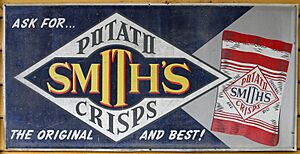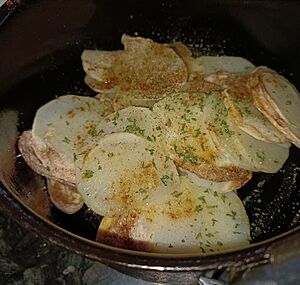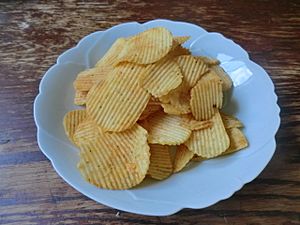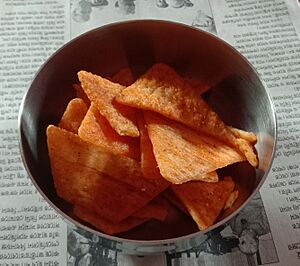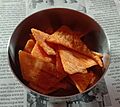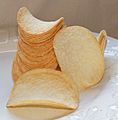Potato chip facts for kids

A pile of kettle-cooked potato chips from Utz Brands
|
|
| Alternative names | Crisps (British and Irish English) |
|---|---|
| Course | Snack, side dish |
| Serving temperature | Room temperature |
A potato chip is a super thin slice of potato that has been fried, baked, or air-fried until it's crunchy. People in North America and Australia usually call them "chips." In the United Kingdom and Ireland, they are called "crisps."
Potato chips are a very popular snack food in many countries. In 2005, people spent over $16 billion on potato chips around the world! That was a big part of the total snack market.
Contents
History of Potato Chips
How Potato Chips Started
The first known recipe for potato chips appeared in a cookbook in 1817. It was written by an English cook named William Kitchiner. His book was very popular in both the UK and the US.
The recipe told people to peel large potatoes and slice them very thin, like peeling a lemon. Then, they should dry the slices well and fry them in hot oil or fat. An old French cooking book from 1825 also had a recipe for thin, fried potato slices. Early American cookbooks also shared Kitchiner's idea.
The Saratoga Chips Story
There's a fun story about how potato chips were invented in Saratoga Springs, New York. This happened much later than the first recipe.
The story says that in 1853, a cook named George Crum was working at Moon's Lake House. A customer kept sending back his French fries, saying they were too thick or not salty enough. Crum got annoyed. He sliced some potatoes super thin, fried them until they were extra crispy, and added lots of salt.
To Crum's surprise, the customer loved them! These new crispy potatoes soon became known as "Saratoga Chips." This name was used for a long time. A company that made chip bags even shared this story in a 1973 ad. They said the picky customer was a rich man named Cornelius Vanderbilt. George Crum was already a famous chef and later opened his own restaurant called Crum's House. The "Saratoga Chips" name is still used today!
How Potato Chips Are Made
In the 1900s, potato chips started to be made in large factories for everyone to buy. One of the oldest potato chip companies in the United States, Mikesell's, started in Ohio in 1910. Another early company, Granite State Potato Chip Factory, began in New Hampshire in 1905.
Adding Flavors to Chips
For a long time, potato chips only came with salt. In 1920, Frank Smith in London started selling chips in paper bags with a small twist of salt inside.
But in the 1950s, things changed! In 1954, Joe "Spud" Murphy and Seamus Burke from an Irish company called Tayto made the world's first flavored chips: cheese & onion. Other companies quickly wanted to learn how they did it.
Soon, companies like Walkers in England also made cheese & onion chips. Then, Smith's came out with salt & vinegar chips. This started a "flavor war" that lasted for many years!
The first flavored chips in the United States were barbecue flavor, also made around 1954.
How Chips Are Packaged
In the past, chips were sold in big tins or glass bins at stores. They were often stale and broken at the bottom.
In the 1920s, a smart lady named Laura Scudder had an idea. She had her workers iron wax paper into bags. The next day, these bags were filled with fresh chips at her factory. This new way of packaging kept the chips fresh and crunchy for longer.
This invention, along with the creation of cellophane (a clear wrapping material), helped potato chips become a huge product that could be sold everywhere. Today, chips come in plastic bags. Nitrogen gas is often put into the bags before sealing them. This gas helps keep the chips fresh and stops them from getting crushed.
Kettle-Cooked Chips Explained
For a long time, chips were made in small batches. Potato slices were rinsed to remove starch, then fried at a low temperature. Workers would stir them to stop them from sticking.
Later, factories started making chips in a continuous process. This meant the chips moved along a conveyor belt through hot oil.
However, some smaller companies kept making chips in batches. In 1980, a company called Cape Cod Potato Chips started making thicker, batch-cooked chips. These became known as "kettle-style" chips. They are thicker and have a harder, crunchier bite because the starch isn't rinsed off. Kettle chips are often seen as a special, "gourmet" snack.
What Are Chips Called?
The name for this snack can be different depending on where you are!
In North America, they are usually called "chips." But in Canada, thick French fries can also be called "chips."
In the United Kingdom and Ireland, they are called "crisps." When they say "chips," they mean French fries (like in "fish and chips").
In Australia, New Zealand, India, and some other places, both thin potato chips and French fries are called "chips." Sometimes, people in Australia and New Zealand will say "hot chips" for French fries and "potato chips" for the thin, crunchy ones.
In Germany and Switzerland, they are called "chips" (pronounced like in English). In Brazil, thin, crunchy chips are called "batata chips" or just "chips."
Are Potato Chips Healthy?
Most potato chips have a lot of salt. Too much salt can be bad for your blood pressure. However, some researchers have pointed out that a small bag of chips can have less salt than some breakfast cereals!
Some chip companies are trying to make healthier chips. They are working on ways to reduce the salt without changing the taste. For example, some companies are trying to make salt crystals that taste saltier on your tongue, so they can use less of it.
You can also find unsalted chips. Some brands even give you a tiny packet of salt inside the bag so you can add just the right amount you like.
There was also a concern about a chemical called acrylamide, which can form when potatoes are fried at high temperatures. This was discovered in 2002. But later research has shown that the acrylamide in cooked food probably doesn't cause cancer in humans.
In 2008, some chip companies in California had to pay fines. This was because their chips had higher levels of acrylamide than allowed by a state law. These companies agreed to lower the acrylamide in their chips. Many chip makers now use special scanners to remove any chips that are too burnt before they are packaged.
Different Kinds of Chips Around the World
Chips in the Americas
In the United States, some popular regional chip brands include Jays, Better Made, Old Dutch, Utz, and Zapp's.
In Canada, you can find unique flavors like "all-dressed" (a mix of many flavors), dill pickle, and ketchup. Ketchup chips taste like tomato, garlic, and onions.
In Colombia, you might find chips flavored like lemon, chicken, or even sirloin steak with mushroom sauce!
Chips in Europe
In the United Kingdom, Walkers makes many popular crisp flavors. These include Prawn Cocktail, Beef and Onion, Roast Chicken, Smoky Bacon, and Salt and Vinegar. They also have more unusual flavors like Thai sweet chili or Stilton cheese and cranberry. In Ireland, the word "Tayto" is so famous that people sometimes use it to mean any kind of potato chip, even if it's not made by the Tayto company.
In Germany, Belgium, and the Netherlands, the most common flavors are salted and sweet paprika. In Germany, you can also find sour cream and onion, cheese, or even flavors like "Currywurst" (a popular German sausage dish). In Belgium and the Netherlands, "Bolognese" (meat sauce) flavored chips are also popular.
In Russia, some chip brands offer unique seafood flavors like grilled salmon, shrimp, or "Kamchatka's crab." Lay's also has crab-flavored chips and green onion chips just for the Russian market.
Chips in Asia
In Japan, you can find many interesting chip flavors. These include norishio (seaweed and salt), consommé, wasabi, soy sauce and butter, garlic, plum, barbecue, pizza, mayonnaise, and black pepper. You might also find chili, scallop with butter, teriyaki, takoyaki (octopus balls), and yakitori (grilled chicken) flavored chips.
In Indonesia, potato chips are called kripik kentang. Major brands include Chitato and Lay's. In 2018, Chitato even launched unusual flavors like beef rendang (a spicy meat dish), fried crab golden egg yolk, and mango sticky rice!
Other Snacks Like Potato Chips
Chips Made from Dough
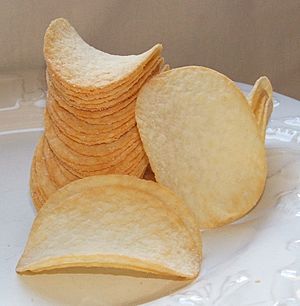
Some snacks, like Pringles and Lay's Stax, are not made from sliced potatoes. Instead, they are made from a dough of dried potato flour. This dough is pressed into a shape and then fried. This makes all the chips the same size and shape, so they can be stacked neatly in a can. Pringles are actually called "potato crisps" in the US.
Potato Sticks and Baked Chips
"Potato sticks" or "shoestring potatoes" are another type of potato snack. They are like very thin French fries but are fried like regular chips. A smoky-flavored version called "Hickory Sticks" is popular in Canada. Potato sticks often come in tall, rigid containers.
Some companies also make baked potato chips. These have less fat than fried chips. There were also some fat-free chips made with artificial fat substitutes. However, these sometimes caused stomach problems for people.
Non-Potato Crisps
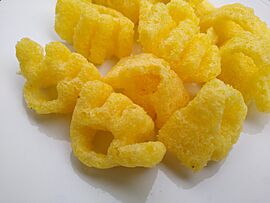
In Britain, many other snacks are called "crisps" even if they are not made from potato slices. Examples include Wotsits, Quavers, Skips, Hula Hoops, and Monster Munch. These are often made from corn or other grains.
Chips from Other Vegetables
You can find chips made from many other vegetables besides potatoes! Sweet potato chips are popular in Korea, New Zealand, and Japan. In the United Kingdom, you might find chips made from parsnips, beetroot, or carrots.
India is famous for its many "chips shops" that sell not only potato chips but also chips made from plantains, tapioca, yams, and even carrots. Plantain chips are also popular in North and South America. In Kenya, chips are made from arrowroot and cassava.
Images for kids
See also
 In Spanish: Papas fritas inglesas para niños
In Spanish: Papas fritas inglesas para niños
- Chips and dip
- Corn chip
- Tornado potato
- List of deep fried foods
- List of potato dishes
- Papadum
- Vegetable chips


